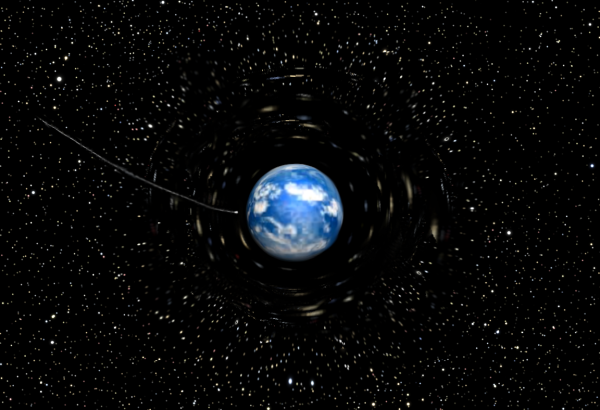BY LETTER
Baryos
Culture and Society > Myths and the Unexplained > Artefacts (Artifacts)
Galactography > Systems and Worlds > Systems & Worlds A - B
Galactography > Systems and Worlds > Systems & Worlds A - B
 Image from Steve Bowers | |
| The strong gravity field around Baryos can be observed directly through gravitational lensing. If an asteroid were to strike the planet, it would do so with extreme force | |
Baryos was originally a close binary star system consisting of two F-class stars of a little over 1.6 and 1.4 solar masses designated YTS 8171-4644-522, located in the Carina Rush 6514 light years from Sol. First colonized by ahuman or solipsist entities of Terragen origin, intelligent activity in the form of starlifting infrastructure was first observed in 7522 AT by the local telescopes of the Utopia Sphere colony system Ylli Farscapes located some 38 light years away. With the local archives and later the Known Net confirming no record of a Sephirotic-affiliated colonization mission, it was concluded that the system was home to a typical ahuman civilization engaged in the construction of an ordinary computronium megastructure.
Continued observations, however, revealed numerous anomalies in the behavior of the ahuman swarm, causing much debate over just what was actually being done. Fears were raised of a bizarre new kind of perversity. By 8700 AT, however, all visible activity in the system had ceased. In place of the former binary star was a highly compact, massive gravitational lensing anomaly, orbited by a tiny luminous object and a Jovian-mass object emitting high levels of infrared radiation. In 8721 AT a Keterist expedition from the nearest Sephirotic system arrived to investigate.
What was found was most unusual: a terrestrial 'planet', designated Baryos, located in the core of a neutrino star of 3 solar masses. Neutrinos seldom interact with normal matter, but have a positive mass. A sufficiently large and cold mass of neutrinos can be used to form an invisible cloud held together by gravity. Orbiting the neutrino star and its planet is an artisun of 0.05 Earth masses, named Tachys, providing Earthlike insolation to the planet. In a much more distant orbit is the Jovian-mass object, an uncommunicative J-brain.
Gravity on the surface of Baryos is just 1.2 G, since the strength of a local gravitational field depends only on the mass inside the radius where it is measured. However, Tachys, orbiting 450,000 kilometers away, experiences the gravitational effect of nearly one solar mass, making an orbit in just 57 minutes. The escape velocity from Baryos is 10,000 kilometers per second.
Baryos is covered by a deep ocean, with an average depth of 6 kilometers. The planet has a large cross section for infalling matter, which would normally make meteor impacts common, as well as extremely powerful and damaging. However, the system appears to have been cleared of all potential impactors, lacking even an Oort cloud.
Life on Baryos is not very exotic, being based on left-handed amino acids, a nucleic acid using six nucleotides, and with starches doing many functions performed by proteins in terrestrial life. A rich biosphere of pelagic creatures exist, with titanic filter-feeding "whales" grazing algae fields, various hunting swimmers, migrating hive-like schools of small creatures and a complex ecology of scavengers on the seafloor. No species with highly developed intelligence has been observed, and it is unlikely that any will evolve due to limitations on Baryan neurochemistry.
In the end, Baryos stands as yet another of the wonders of the Terragen Sphere. Scientific expeditions have been able to carry out their work freely, but the J-brain has ignored all attempts at communication with it. It is generally presumed that the being(s) within observe and safeguard Baryos and its biosphere. The presence of the Baryos entity and the difficulty of accessing the planet have deterred any attempts at permanent settlement.
It has been suggested that Baryos is everything from an artwork to a warning to a prison, but absolutely no evidence supports any one conclusion.
Appears in Topics
Development Notes
Text by ProxCenBound and Anders Sandberg
Original by Anders Sandberg; revised 28 August 2023 by ProxCenBound
Initially published on 08 October 2001.
Original by Anders Sandberg; revised 28 August 2023 by ProxCenBound
Initially published on 08 October 2001.






